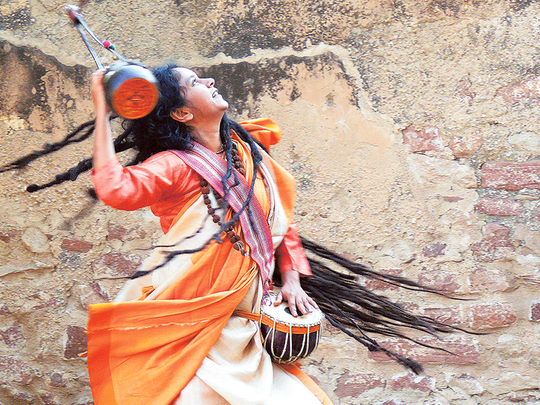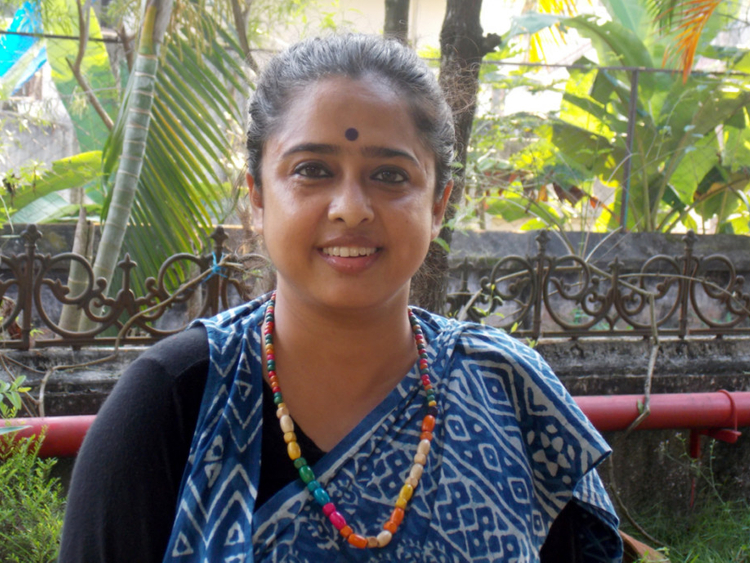
Mukolakkal in Nedumangad (Thiruvananthapuram, Kerala) is the unlikeliest place to meet a “baul” artiste, those mystical singers of West Bengal.
So it was quite a surprise to find Chittoor House, (the home of Ravi Gopalan Nair, a glove puppet artiste) playing host to Debdas Baul, Kanai Das Baul, Syam Sundar Das Baul and Lakshman Das Baul.
The ambience was perfect, as I made my way through the garden on an ebony night to be ushered into an alcove lit up with traditional brass lamps.
Even as the golden flames swayed in the gentle breeze, a baul singer’s voice rose. Fellow artistes drummed on “dholaks” (percussion instrument) while he plucked at the lone string of his “ektara” (a stringed instrument). And, he also danced. Keeping pace with the music were the anklets on his feet as they gently kissed away the stillness of the night.
An unusual congregation of people sat on the floor soaking in the soulful music. There was Aurelio, an Austrian from Puducherry, India; Valerie and Samuel, a couple from France; Ganesh Mulchandani from Mumbai, India; and from Kolkata, India was Dipanita Acharya.
It was a motley crowd that cut across gender, race, community and religion: the only common thread binding them was their fascination for baul music.
Bringing them all under her roof was Parvathy Baul, (Ravi’s wife), an accomplished baul singer. It was part of a baul retreat she had organised last December at her home.
For the past 22 years, Parvathy has been singing in the baul tradition performing in India and also abroad, including in the United States, Germany, Turkey, UAE and Denmark.
Soon she will be packing bags for Bogota (South America), for a musical event organised by the national cultural academy.
At Bogota, Parvathy will be collaborating once again with Italian violinist Elena Floris and Iben Nagel Rasmussen, actor-director from Odin Teatret of Denmark. They had come together last June during the 50th anniversary celebrations of Odin Tretret Nordish Teaterlaboratorium in Denmark.
This is a never-before explored experiment of Western classical music meeting Indian music, with Elena Floris’s pieces of traditional Italian melodies, gypsy music and classical composers (such as Mozart, Tschaikovsky, Rota) merged with Iben Nagel Rasmussen rendition of poems (of Chilean poet Pablo Neruda, Turkish poet Nazim Hikmet and German Bertolt Brecht) and Parvathy’s baul music.
Doesn’t the alien language come in the way of understanding baul music by the audience abroad? I wondered aloud.
Parvathy tells me, “When the sound is sincere, from the heart and when music talks about love and surrender, it is bound to touch every heart. Baul music is healing and refreshes the listener.”
“It’s like stepping out of a shower,” continues the 38-year-old singer, whose long matted tresses fall below her hips. “When I am exhausted, I find solace in baul music. You don’t have to understand the language if you wish to experience love. We may be separated by different cultures and geography, but life’s experiences are the same everywhere.”
Having travelled extensively, Parvathy finds that her perspective of the world has widened, making her more aware of life in other parts of the world.
“It has enhanced my spiritual work. One travel is equal to a hundred lessons.”
Rooted in Bangladesh and West Bengal, baul music was common in the 19th and early 20th century when singing minstrels earned their bread through music. Baul music greatly influenced the compositions of Nobel laureate Rabindranath Tagore.
In 2005, this traditional form of music native to West Bengal was included in the list of Masterpieces of the Oral and Intangible Heritage of Humanity by Unesco.
Growing up in West Bengal in the Seventies, I remember listening to their songs while travelling on local trains. You just couldn’t miss them in their orange attire, carrying an “ektara” in one hand and a “duggi” (small drum) in the other. And, when they sang, their voices rose above the din of the crowd and the hoot of the trains, leaving a lasting impression.
Today their numbers have dwindled, even in West Bengal. But, if this music has found a global podium, it’s all due to Parvathy’s endeavour.
Like all stories of endurance, Parvathy’s musical journey was marked with hardship and road-blocks. Rebelling against her family, living penniless and battling health problems so that she could follow the call of her heart, Parvathy’s love affair with baul music can be traced to her teens.
It was on a train journey that Parvathy first listened to baul music. She was 16 then and just out of school.
“I was travelling to Shantiniketan to join for a degree in Arts,” reminisces Parvathy, who was born in Assam as Moushumi Pariyal.
“A blind baul singer entered the train and started singing. Although I did not understand the meaning of his song, I was enchanted by its music. There was something poetic about it. His voice flowed freely and I connected to it instantly. Something in my mind said, ‘This is where I belong. This is my home.’ Even after alighting from the train, the sound of the “ektara” and the singer’s voice stayed long within my mind.”
Joining Shantiniketan with dreams of becoming an independent artist, Moushumi pushed away the image of the baul singer.
But destiny had other plans. A college assignment required her to paint a Baul singer.
“There is a tranquility on the face of a baul singer and our class project involved capturing that on canvas.”
She visited the ashram of baul singer Bipod Tarun Das and, before she knew it, she was hooked on to his music. Meeting Phoolmala Debi, a woman baul singer, whet her appetite for more.
“I used to visit her on Sundays to learn music. She was like a mother to me.”
What started as a hobby soon became a passion.
“Phoolmala Debi suggested that I train formally under a guru.”
Now who would be her guru?
Destiny intervened again when Baba Sanatan Das Baul, a noted baul singer, performed at Shantiniketan during the annual festival.
“I listened to his famous song, ‘Kalia’ describing the love of Krishna and Radha. I was transported to Brindavan, as Krishna and his gopis came alive through the song,” recounts Parvathy.
“Baba’s music was similar to an artwork, the only difference being that he painted in space. I was enthralled completely and determined to learn Baul music. I decided that he would be my guru.”
Her family was certainly not happy with her new-found love. They disapproved of her passion that meant singing for a livelihood.
“Where will all this lead to,’ they wondered. It irked them to see me dressed like bauls and walking around with an ektara,” remembers Parvathy.
“When I told them one day that I am going to my guru, they did not take me seriously. They presumed it was one of those phases a 17-year-old goes through. But I was fearless and determined.”
She quit her course at Shantiniketan and with no money on her, reached Bankura, (around 100 kilometres away), where Baba Sanatan Das lived. The 72-year-old was surprised to find a teenager at his door.
“The first day he did not even talk to me. But his family members took me in, fed me and allowed me to work in the ashram. Fifteen days later, he called me and asked my name.”
Baba Sanatan Das told her, “Looks like you are determined to learn.”
He then asked her to join him on his walk to the market.
“On the way he asked me to sing along with him. We stopped singing on reaching the market. On our return Baba asked me to sing the songs again,” recalls Parvathy.
“I was taken aback. I was not sure if I would remember the lines, but I did manage. It convinced him of my earnestness to learn baul music.” Baba Sanatan Das had one question though.
“What’s the use of teaching you? After some time you will marry and start your own family. My efforts will be in vain then.”
It was then that she took a vow not to marry or have a family. Over the next two years, she learnt all that she could under Baba Sanatan Das. Baul music is rendered in the oral tradition.
In 1997, her travels in South India took her to Kerala, where she met Ravi Gopalan Nair, a glove puppet artiste in Thiruvananthapuram.
Here, she also found her spiritual guru, Abdul Salam.
“Ravi being a traditional puppeteer was involved in other folk arts, so I had the opportunity to observe traditional masters. I learnt yoga, Kalaripayattu and Thaiyam, which helped me understand my body, its relationship with the universe and to realise the divine through the body. My Baul work has grown tremendously due to Ravi’s support.”
Travelling with Ravi she found a platform for her music.
Parvathy’s first international concert was in Lebanon in 2000.
It happened after she met French anthropologist Francoise Grund, a storyteller, on her visit to Kerala.
“She narrated stories using her own paintings and when she noticed that I explained baul music similarly, using my paintings, she found it unique and invited me for a storytelling festival in Lebanon.”
The same year, Parvathy worked with Peter Schumann of Bread and Puppet Theater. In Thiruvananthapuram, the husband-wife duo manage a school for baul music, Ekthara Baul Sangeetha Kalari.
What about the challenges of being a woman baul singer?
“There were obstacles, but they soon turned into learning lessons. In a male dominated society, it is really hard for a woman to choose a life that she wants.
“Women in ‘baul parampara’ remain in the background. They are not acknowledged although they are the ones holding the community together.”
Having broken these shackles, Parvathy today stands in a niche of her own. She often visits her guru Baba Sanatan Das.
And, in all likelihood, the 97-year-old Baba must be smiling to himself at the memory of the teenager who refused to take a “no” from him and whose persistence has transported baul music from the streets to a world podium, giving it the dignity it deserves.
Parvathy’s music can be found on YouTube.
Mythily Ramachandran is a writer based in Chennai, India.














